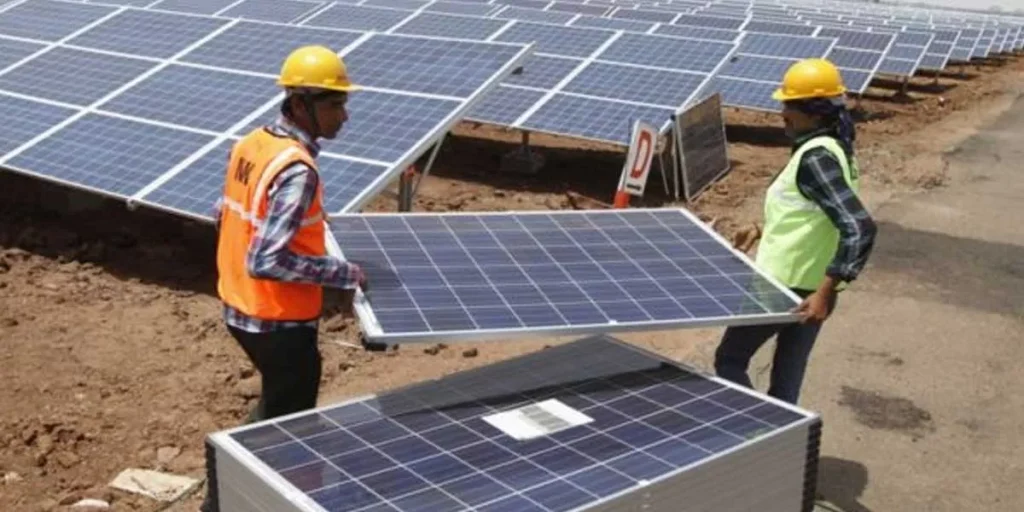Context:
India had planned to have 175 GW of renewable energy capacity, including 100 GW from Solar Energy.
More on the News

- India’s solar power sector has witnessed an extraordinary 3450 % increase in capacity over the past decade, rising from 2.82 GW in 2014 to 100 GW in 2025.
- As of January 31, 2025, India’s total solar capacity installed stands at 100.33 GW.
- In 2024, a record-breaking 24.5 GW (including rooftop solar energy’s 4.59 GW) of solar capacity was added reflecting a more than two-fold increase in solar installations compared to 2023.
- Solar energy accounts dominant 47% of the total installed renewable energy capacity.
- Rajasthan, Gujarat, and Tamil Nadu emerged as the top-performing states, contributing 71% of India’s total utility-scale solar installations.
- Solar module production capacity has surged to 60 GW in 2024, With continued policy support, India is on track to achieve a solar module production capacity of 100 GW by 2030.
- India is making significant progress in transitioning from a net importer to a net exporter of solar photovoltaic (PV) products, with the export value rising 23 times to $ 2 billion in the Fiscal Year (FY) 2024 from FY2022.
Significance of solar energy for India
- According to the Ministry of New and Renewable Energy, India’s solar power potential is around 748 GW, which is significantly more than the country’s future solar energy demand (229 in 2023 expected).
- It is helpful in achieving India’s ambitious target of 500 GW of non-fossil fuel-based energy capacity by 2030.
- It is instrumental in achieving India’s Nationally Determined Contribution (NDC) submitted to the United Nations Framework Convention for Climate Change (UNFCCC), India aims to reduce the Emissions Intensity of its GDP by 45 percent by 2030, from the 2005 level.
- It is also helpful target for establishing 50% cumulative electric power installed capacity from non-fossil fuel-based energy resources by 2030.
Key Government Initiatives/Schemes for Solar Energy Development
National Solar Mission (NSM): It was Launched in 2010 to promote ecologically sustainable growth while addressing India’s energy security challenges.
Key schemes under the National Solar Mission (NSM)
- Solar Park Scheme for setting up at least 50 Solar Parks targeting 40,000 MW of solar power projects.
- Scheme for setting up 12,000 MW of Grid-Connected Solar PV Power Projects by the Government producers with Viability Gap Funding (VGF).
- Installation of Grid-Connected Solar Rooftop Power Plants.
- Pradhan Mantri Kisan Urja Suraksha evam Utthaan Mahabhiyan (PM-KUSUM).
- Production-linked incentive scheme under “National Programme on High Efficiency Solar PV Modules.”
Permitting Foreign Direct Investment (FDI) up to 100 percent under the automatic route.
Waiver of Inter-State Transmission System (ISTS) charges for inter-state sale of solar and wind power for projects to be commissioned by 30th June 2025.
Development of Solar Parks and Ultra-Mega Solar Power Projects: It was launched in 2014 by the Ministry of New & Renewable to set up at least 25 Solar Parks and Ultra Mega Solar Power Projects targeting 20,000 MW of solar power installed capacity within a span of 5 years starting from 2014-15.
- The capacity of the Scheme was enhanced from 20,000 MW to 40,000 MW on 21-03-2017. These parks are proposed to be set up by 2025-26.
- As per the Ministry of New and Renewable Energy (MNRE), As of March 2024, there are a total of 58 solar parks in India with a sanctioned capacity of 40 GW.
Solar panels: Notification of standards for deployment of solar photovoltaic systems/devices.
- India also exported $25 million of photovoltaic cells that were not assembled into modules in April-October FY25 with 90 per cent of the exports going to the US
- Standard Bidding Guidelines for tariff-based competitive bidding process for procurement of Power from Grid Connected Solar PV and Wind Projects.
Rooftop solar projects: Schemes such as Pradhan Mantri Kisan Urja Suraksha evam Utthaan Mahabhiyan (PMKUSUM), Solar Rooftop Phase II, 12000 MW CPSU Scheme Phase II, etc were launched to boost the rooftop solar sector.
- PM Surya Ghar: Muft Bijli Yojana launched in 2024, is now nearing 9 lakh rooftop solar installations.

